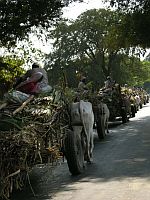Friday, April 19, 2024
News and Views from the Global South
DEVELOPMENT-INDIA: Subsidies Cornered by Politically Powerful
Jaideep Hardikar*
- An intensifying agrarian crisis claimed the life of at least one cotton farmer every day last year in Maharashtra, western India. But government subsidies were monopolised by the state’s powerful sugar lobby.

Sugarcane farmers taking their yield to a cooperative sugar mill near Baramati, Pune district. Credit: Jaideep Hardikar/IPS
In 2007, subsidies to sugar mills – run by cooperatives headed by political heavyweights like Indian Agriculture Minister Sharad Pawar and Maharashtra Chief Minister Vilasrao Deshmukh – ran into several million rupees.
"The state government paid nearly 800 crore rupees (200 million US dollars) by going out of its way to help the sugar industry last year," a top official who did not want to reveal his name, told IPS.
Faced with a glut in production and falling global prices, both the state and central governments announced export subsidies that added up to 61 dollars per tonne. Later in the year, the purchase tax of 63 million dollars was waived from sugar mills, which received a subsidy of 212 million dollars for a buffer stock.
Last September, the government had extended its guarantee to enable loss-making sugar cooperatives to raise fresh money. Among direct beneficiaries were the chief minister, three ministers, and Ajit Pawar, the nephew of agriculture minister Pawar – all managers of sugar cooperatives in their respective constituencies.
Meanwhile, Maharashtra’s cotton farmers and industry remained in the doldrums. In 2005, the state government withdrew an advance bonus of 500 rupees (12 dollars) a quintal on the cotton support price, triggering a steep fall in prices and heavy loss to cultivators, already in debt and desperate for financial support. Close to 2,000 cotton farmers in Vidarbha’s six cotton districts took their own lives that year.
In January 2007, the state government announced aid worth a paltry 37 dollars per hectare (I ha=approx 2.46 acres) for cotton farmers owning up to 2 ha of land. Later it announced 625 dollars per ha compensation, irrespective of the size of holdings, for cane that was not crushed in mills because of a bumper harvest of eight million tonnes.
This year, with the government raising the blending limit for biofuels to 10 percent, many mill managements have taken over defunct mills to crush the extra sugarcane. For instance, the Warna group a sugar mill in Bodegaon, Yavatmal district in Vidarbha.
Sugar mills are lobbying hard for two subsidies given last year. Those that continued with crushing operations beyond Apr. 16, when temperatures begin to rise, were paid 100 rupees (2.5 dollars) a tonne for every 1 percent drop in the average recovery rate. Also, a massive transport subsidy for crushing cane came from outside their area of operation.
Maharashtra’s sugar industry has thrived on political patronage. Budgetary allocations have been lopsided, and regions like Vidarbha and Marathawada have suffered.
Member of the Statutory Development Board for Vidarbha, advocate Madhukar Kimmatkar, points to a skewed energy consumption pattern.
While Vidarbha’s 3.2 million farm families consume 11.5 percent of total electricity, the sugarcane belt accounts for 65.5 percent. The six sugar growing districts of Pune revenue division had 35,720 motor pumps in excess of the quota for 2004, while Vidarbha had a deficit of 215,000.
A subsidy of 230 dollars per pump to keep cost of production down benefits the western Maharashtra farmer and sugar industry, Kimmatkar says.
Farm leader Jawandhia says with global sugar prices falling further in 2007, New Delhi waived excise duty on the mills and gave a zero-interest loan of 280 million dollars. Much of that money went to the mills run by cooperative barons within the government.
On Mar. 5, 2008, the National Bank for Agriculture and Rural Development (NABARD) announced a 500-million dollar package for 88 cooperative sugar mills in crisis. Loan recovery was restructured to between three and 15 years, with a moratorium for five years. The central government will bear the interest burden of 150 million dollars.
Subsidies and sops prop up the seriously mismanaged cooperatives, and shield cane farmers from price volatility. Yet, cotton farmers are exposed to global price fluctuations.
Public money was also squandered on the state’s textile mills, managed by powerful political interests. Maharashtra’s comptroller and auditor general published a damning report on sick mills that eventually shut down.
Between 1961-2001, the government released "752.44 crore rupees (188 million dollars) to 116 cooperative spinning mills on extraneous conditions and in total disregard of the advice of the Planning and Finance departments," the report for 2002-03 states.
Eventually, 12 mills closed, 15 were under liquidation and 39 suffered accumulated losses of 95 million dollars. "Thus, the government investment in these mills has become dead," the report concludes.
A tragic waste, because Vidarbha’s starving cotton farmers could have found an assured market in the cooperative textile mills.
(This is the second story in a series on the role of subsidies in Indian agriculture.)

 Print
Print



